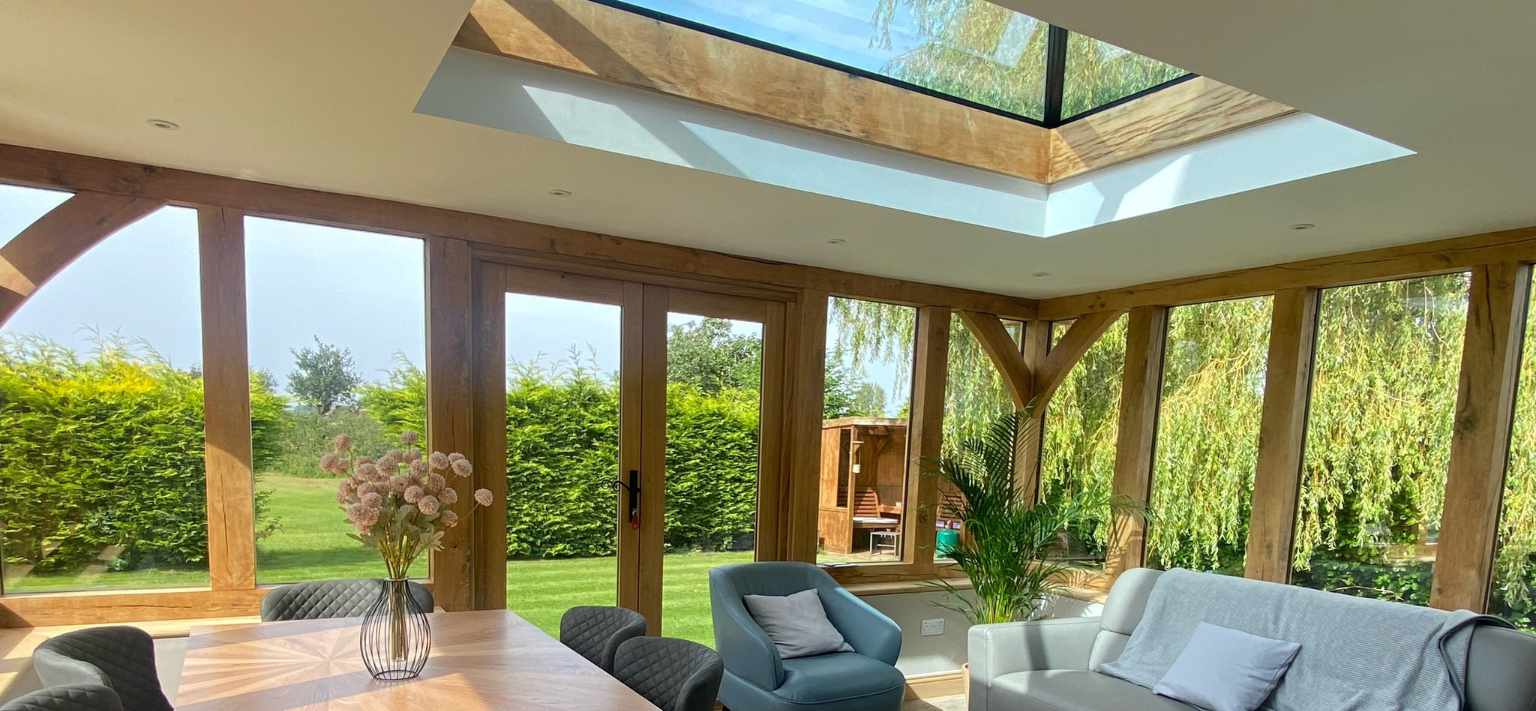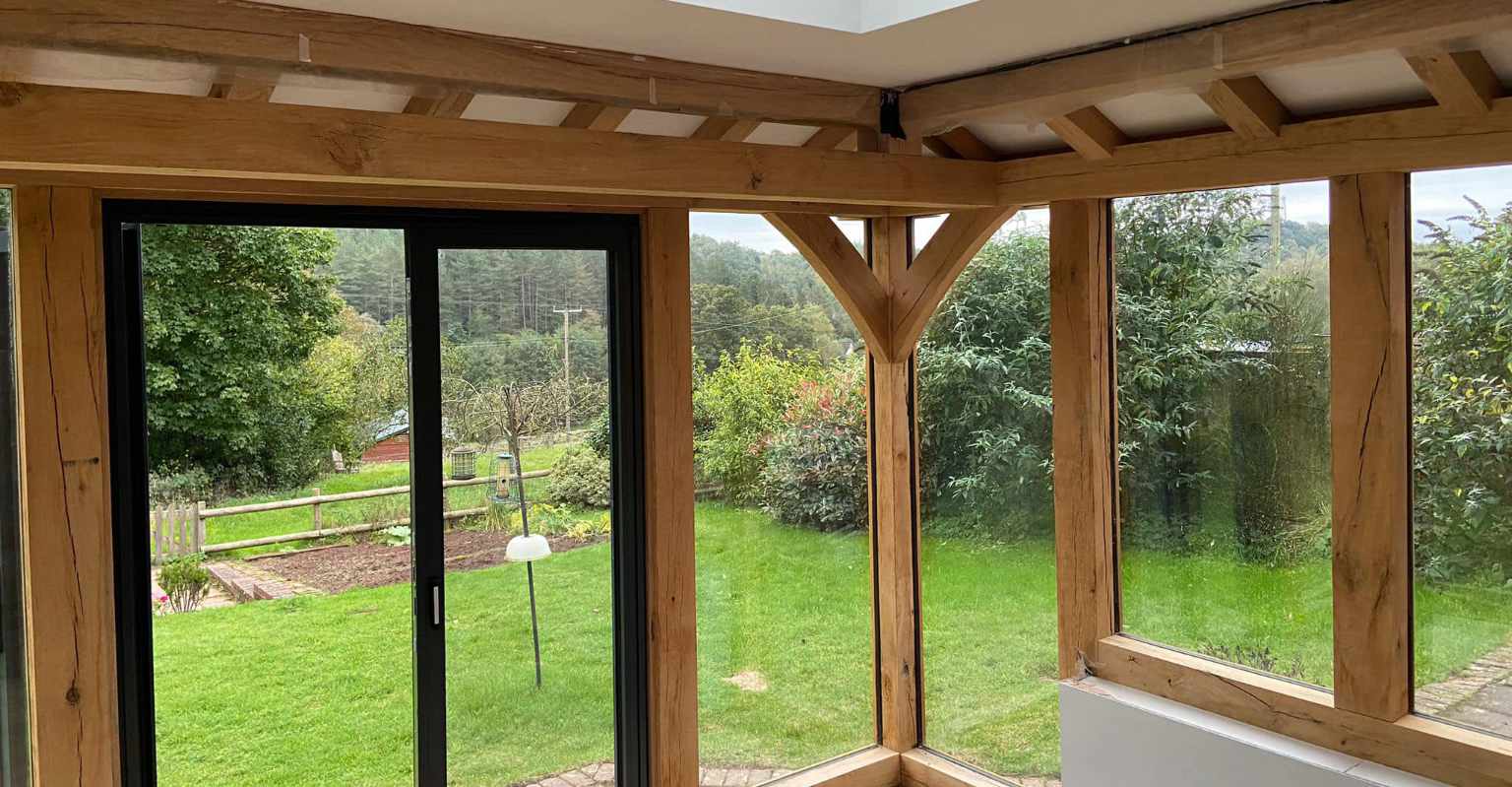The Ultimate Guide to Glazing Oak Framed Buildings
Contents
Glazing, or glass, can be a stunning addition to your oak building, allowing for views of the surrounding area and the admittance of natural light into your space.
However, whilst working with external glazing, it's important to get it right. Ensure you keep energy costs under control, reduce your risk of sun glare, and avoid numerous other hiccups with our ultimate guide to glazing…

Importance of Selecting the Right Type of Glazing for Oak Framed Buildings
When investing in an oak framed building for your home, you want to ensure every detail is as expected. This includes your glazing, which plays an important part in regulating temperature and light within your building.
The amount and type of glazing should be suitable for your geographical location and the intended use of the space, as well as meeting your design requirements.
Glazing should keep your home cool in warmer months, whilst keeping heat inside during the colder months. Too much of the wrong type of glazing can result in excess heat and glare caused by the sun; glare from direct sunlight can affect the visibility of television, desktop and laptop screens, which can make the space difficult to enjoy fully at all times.
Alongside this, you could further experience poor thermal insulation, which leads to increased energy bills over the winter period.
Location additionally plays a role in selecting the most appropriate glazing for your building. Consider whether your area is subject to extreme climates, higher winds or driving rain, which would require a particular type of glazing.
We explore the different types of glazing, and their applications, in more detail below…

Types of Glazing for Oak Framed Buildings
There are several types of glazing for oak framed buildings, meaning you can select the right type of glazing for your home and location.
Single Glazing
Single glazing consists of only one pane of glass, which can range from between 3mm and 10mm in thickness.
Single glazing is the most cost-effective glazing option, however has the least insulation capabilities in terms of both sound and heat, and is prone to condensation build up. For this reason, single glazing is not commonly found in new-build homes, but instead is typically used for buildings that do not require controlled internal environments.
Double Glazing
Double glazing takes advantage of two panes of glass, which are separated by a space filled with a desiccant gas, such as argon. The gas acts as a natural insulator and prevents heat from being lost out of the window due to convection. Desiccant gases are also used to maintain dryness within the window, preventing condensation between the panels.
Because it utilises more panels than single glazing, double glazing offers advantageous thermal and sound insulation capabilities, as well as being harder to break.
Double glazing is suitable for all types of homes and properties.
Triple Glazing
Triple glazing is made up of three panes of glass and two pockets of a desiccant gas, one between each panel.
It’s important to note that the depth of the glazing system affects its thermal performance, with a greater depth providing greater performance. This means triple glazing offers reduced noise levels and significantly increased thermal efficiency compared to double glazing; triple glazing boasts some of the highest performing energy levels available.
On the other hand, it is also more expensive than double or single glazing.
Triple glazing is popular in colder climates or for homes looking to take advantage of greater energy savings.

Laminated Glass
Laminated glass is much tougher than ordinary glazing. Laminated glass is created by bonding two plies of glass to form a permanent bond that retains structural integrity even when impacted or broken.
For this reason, laminated glass is advised for areas or properties with a higher risk of break ins and natural disasters, as well as for use in skylights and glass roofs. Another common application for laminated glass is for commercial buildings.
Other Specialised Glazing Options
For those looking for specialised options, the above glazing is also available as:
Tinted
Tinted glazing involves the incorporation of colouring additives to transparent glass, most commonly in the colours bronze, grey, blue and green. Tinted glass can add a pop of colour, increased privacy, and reduced sun glare and heat intensity to your glazing.
Solar Control Glass
Solar control glass is designed to control excessive heat and glare from the sun entering your building and making it uncomfortably hot.
Solar glass may be preferable in spaces with high volumes of glazing, such as conservatories and orangeries.
Choosing the right type of glazing is worth taking some time to carry out research or consult an expert on glazing oak framed buildings. Not only could you save on costs in the long-term, but you will be able to increase the enjoyability and experience of your new oak building.
Enville Oak provides a comprehensive service when constructing bespoke oak buildings, and can install glazing of your choice to meet design specifications.
Interested in this article? Read others like it...